Comparative Nectary Morphology across Cleomaceae (Brassicales)
Abstract
1. Introduction
2. Results
2.1. Arivela viscosa
2.2. Cleome amblyocarpa
2.3. Cleome violacea
2.4. Gynandropsis gynandra
2.5. Melidiscus giganteus
2.6. Polanisia dodecandra
2.7. Sieruela hirta
2.8. Sieruela rutidosperma
2.9. Tarenaya houtteana
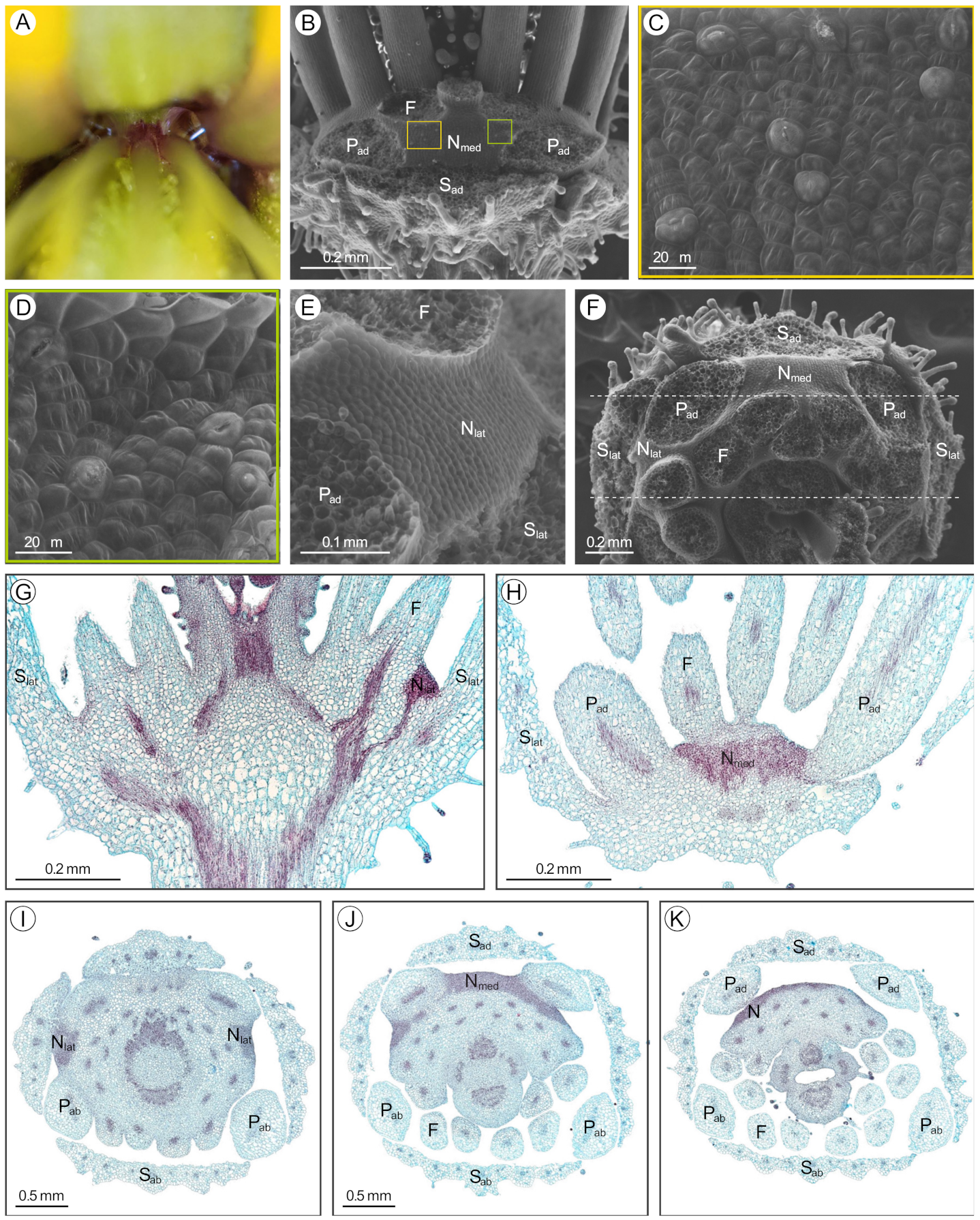
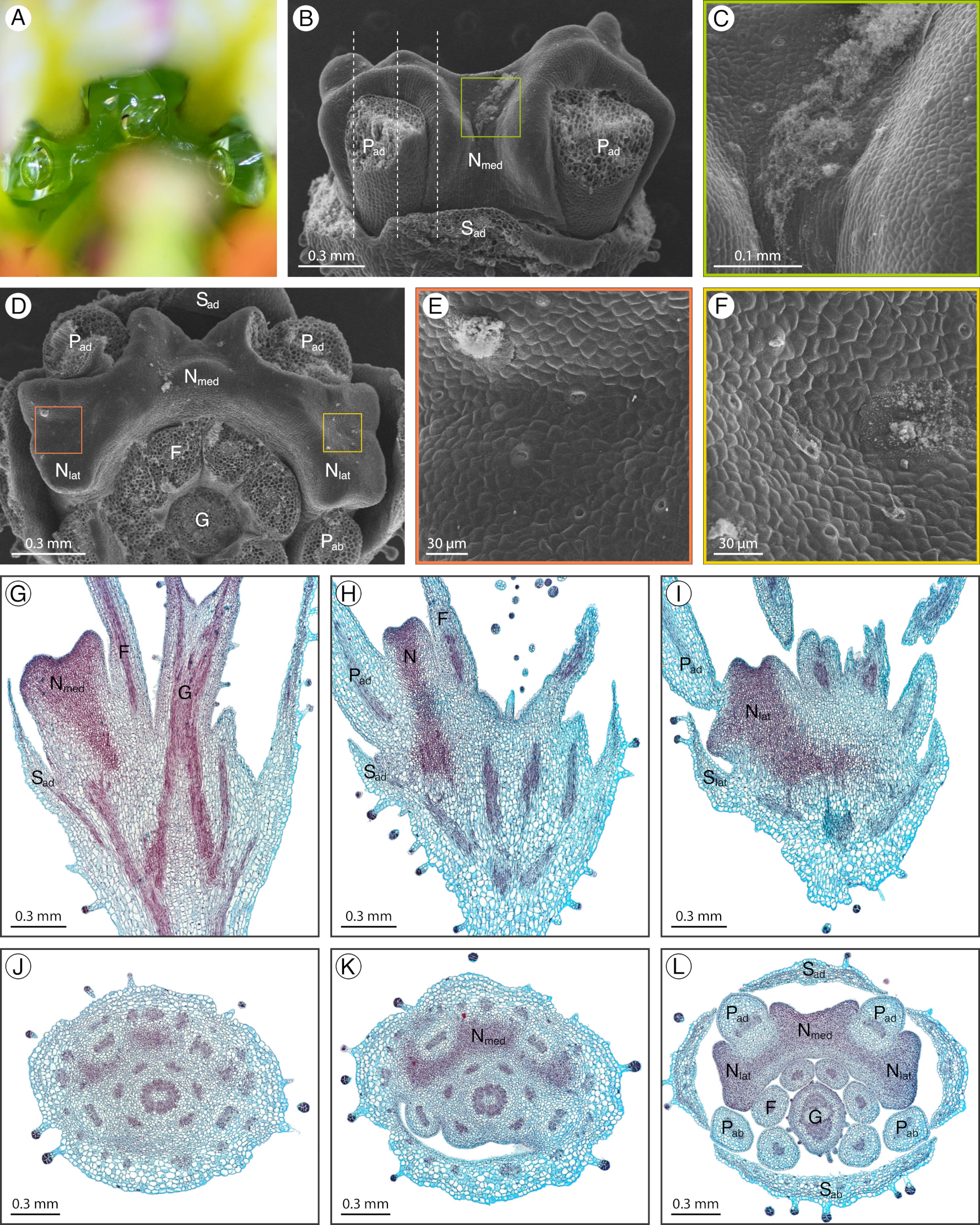


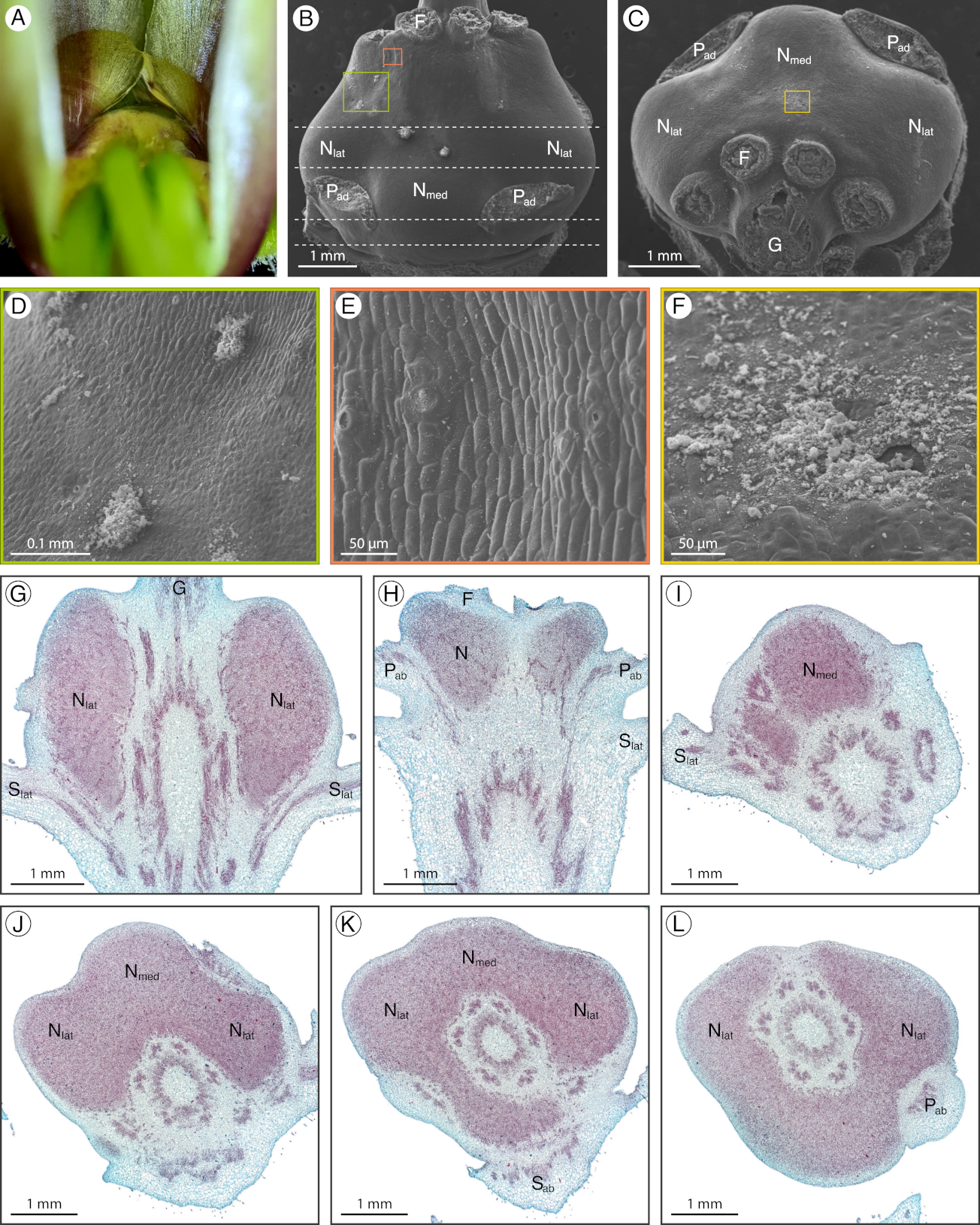

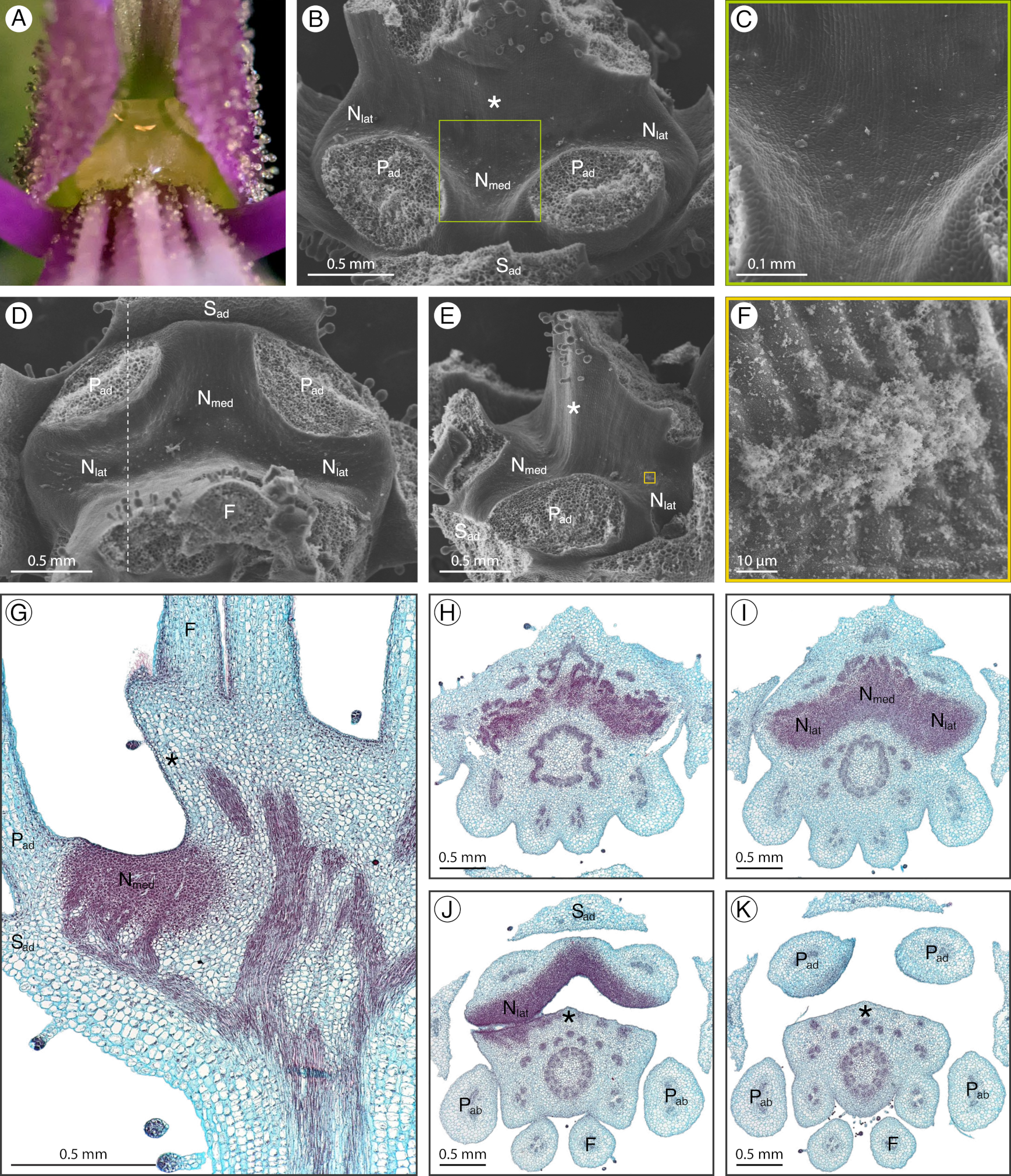


3. Discussion
3.1. Nectarostomata and Vasculature Are Unifying Features of Cleomaceae Floral Nectaries

| Species | Nectary Type | Nectary Location | Nectary Parenchyma | Nectary Vasculature | Nectar Secretion Mechanism | Pollination System |
|---|---|---|---|---|---|---|
| Arivela viscosa | Slightly concave adaxial | Between perianth and stamens | Present | Present | Nectarostomata | Generalist [18,39,40] |
| Cleome amblyocarpa | Protruding adaxial | Between perianth and stamens | Present | Present | Nectarostomata | Unknown |
| Cleome violacea | Protruding adaxial | Between perianth and stamens | Absent/not prominent | Present | Nectarostomata | Unknown |
| Gynandropsis gynandra | Annular | Between perianth and androgynophore | Present | Present | Nectarostomata | Generalist/hawkmoth [18,39,41,42] |
| Melidiscus giganteus | Annular | Between perianth and stamens | Present | Present | Nectarostomata | Bat [20] |
| Polanisia dodecandra | Protruding adaxial | Between perianth and stamens | Present | Present | Nectarostomata | Generalist [17] |
| Sieruela hirta | Concave adaxial | Between perianth and stamens | Present | Present | Nectarostomata | Unknown |
| Sieruela rutidosperma | Concave adaxial | Between perianth and stamens | Present | Present | Nectarostomata | Generalist [43] |
| Tarenaya houtteana | Annular | Between perianth and stamens | Present | Present | Nectarostomata | Bat [19] |
3.2. Nectary Parenchyma Is Variable throughout Cleomaceae
3.3. Evolutionary Lability in Floral Nectary Morphology across Cleomaceae
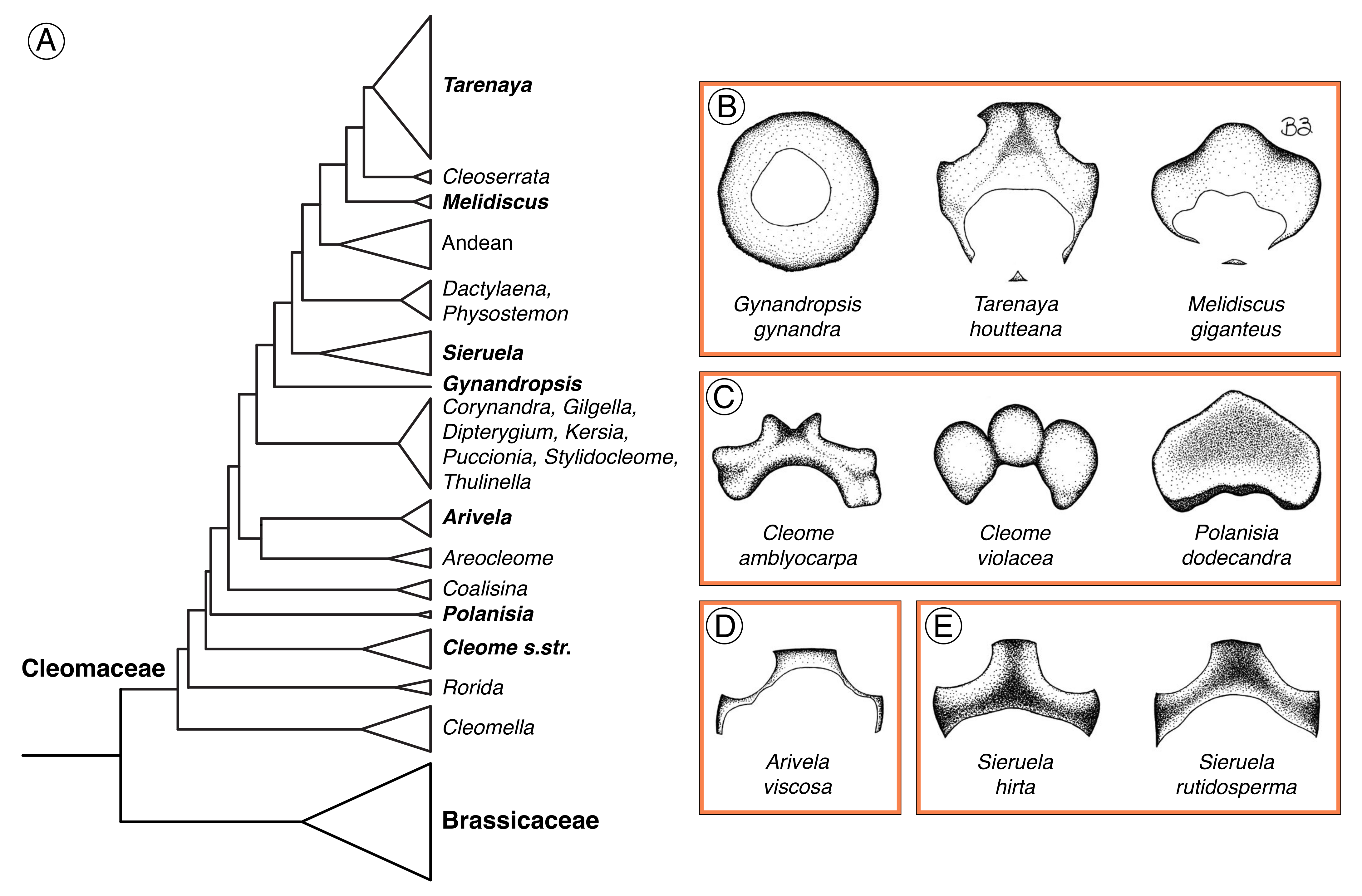
4. Materials and Methods
4.1. Plant Material
4.2. Scanning Electron Microscopy
4.3. Histological Preparations
4.4. Fast Green and Safranin O Staining
5. Conclusions
Supplementary Materials
Author Contributions
Funding
Data Availability Statement
Acknowledgments
Conflicts of Interest
References
- Willmer, P. Pollination and Floral Ecology; Princeton University Press: Princeton, NJ, USA, 2011. [Google Scholar]
- Roy, R.; Schmitt, A.J.; Thomas, J.B.; Carter, C.J. Review: Nectar biology: From molecules to ecosystems. Plant Sci. 2017, 262, 148–164. [Google Scholar] [CrossRef] [PubMed]
- Slavković, F.; Dogimont, C.; Morin, H.; Boualem, A.; Bendahmane, A. The genetic control of nectary development. Trends Plant Sci. 2021, 26, 260–271. [Google Scholar] [CrossRef] [PubMed]
- Nicolson, S.W.; Nepi, M.; Pacini, E. Nectaries and Nectar; Springer: Dordrecht, The Netherlands, 2007. [Google Scholar]
- Liao, I.T.; Hileman, L.C.; Roy, R. On the horizon for nectar-related research. Am. J. Bot. 2021, 108, 2326–2330. [Google Scholar] [CrossRef] [PubMed]
- Antoń, S.; Kamińska, M. Comparative floral spur anatomy and nectar secretion in four representatives of Ranunculaceae. Protoplasma 2015, 252, 1587–1601. [Google Scholar] [CrossRef]
- Bayat, S.; Schranz, M.E.; Roalson, E.H.; Hall, J.C. Lessons from Cleomaceae, the sister of crucifers. Trends Plant Sci. 2018, 23, 808–821. [Google Scholar] [CrossRef]
- Cardinal-McTeague, W.M.; Sytsma, K.J.; Hall, J.C. Biogeography and diversification of Brassicales: A 103 million year tale. Mol. Phylogenet. Evol. 2016, 99, 204–224. [Google Scholar] [CrossRef]
- Iltis, H.H.; Hall, J.C.; Cochrane, T.S.; Sytsma, K.J. Studies in the Cleomaceae I. on the separate recognition of Capparaceae, Cleomaceae, and Brassicaceae. Ann. Mo. Bot. Gard. 2011, 98, 28–36. [Google Scholar] [CrossRef]
- Erbar, C.; Leins, P. Studies on the early floral development in Cleomoideae (Capparaceae) with emphasis on the androecial development. Plant Syst. Evol. 1997, 206, 119–132. [Google Scholar] [CrossRef]
- Patchell, M.J.; Bolton, M.C.; Mankowski, P.; Hall, J.C. Comparative floral development in Cleomaceae reveals two distinct pathways leading to monosymmetry. Int. J. Plant Sci. 2011, 172, 352–365. [Google Scholar] [CrossRef]
- Stoudt, H.N. The floral morphology of some of the Capparidaceae. Am. J. Bot. 1941, 28, 664–675. [Google Scholar] [CrossRef]
- Iltis, H.H. Studies in the Capparidaceae-IV. Polanisia Raf. Brittonia 1958, 10, 33–58. [Google Scholar] [CrossRef]
- Karrer, A.B. Blütenentwicklung und Systematische Stellung der Papaveraceae und Capparaceae. Ph.D. Thesis, University of Zürich, Zürich, Switzerland, 1991. [Google Scholar]
- Thulin, M.; Roalson, E.H. Resurrection of the genus Rorida (Cleomaceae), a distinctive Old World segregate of Cleome . Syst. Bot. 2017, 42, 569–577. [Google Scholar] [CrossRef]
- Cane, J.H. Breeding biologies, seed production and species-rich bee guilds of Cleome lutea and Cleome serrulata (Cleomaceae). Plant Species Biol. 2008, 23, 152–158. [Google Scholar] [CrossRef]
- Higuera-Díaz, M.; Manson, J.S.; Hall, J.C. Pollination biology of Cleomella serrulata and Polanisia dodecandra in a protected natural prairie in southern Alberta, Canada. Botany 2015, 93, 745–757. [Google Scholar] [CrossRef]
- Raju, A.J.S.; Rani, D.S. Reproductive ecology of Cleome gynandra and Cleome viscosa (Capparaceae). Phytol. Balc. 2016, 22, 15–28. [Google Scholar]
- Machado, I.; Cristina Lopes, A.; Valentina Leite, A.; Virgíniade Brito Neves, C. Cleome spinosa (Capparaceae): Polygamodioecy and pollination by bats in urban and Caatinga areas, northeastern Brazil. Bot. Jahrb. Syst. Pflanzengesch. Pflanzengeogr. 2006, 127, 69–82. [Google Scholar] [CrossRef]
- Fleming, T.H.; Geiselman, C.; Kress, W.J. The evolution of bat pollination: A phylogenetic perspective. Ann. Bot. 2009, 104, 1017–1043. [Google Scholar] [CrossRef]
- Tucker, G.C.; Vanderpool, S.S. Cleomaceae. In Flora of North America; Oxford University Press: Oxford, UK, 2010; Volume 7. [Google Scholar]
- Patchell, M.J.; Roalson, E.H.; Hall, J.C. Resolved phylogeny of Cleomaceae based on all three genomes. Taxon 2014, 63, 315–328. [Google Scholar] [CrossRef]
- Neto, R.L.S.; Thomas, W.W.; Roalson, E.H.; Barbosa, M.R.d.V. Taxonomic revision of Tarenaya (Cleomaceae). Ann. Mo. Bot. Gard. 2022, 107, 250–313. [Google Scholar] [CrossRef]
- Lee, J.-Y.; Baum, S.F.; Oh, S.-H.; Jiang, C.-Z.; Chen, J.-C.; Bowman, J.L. Recruitment of CRABS CLAW to promote nectary development within the eudicot clade. Development 2005, 132, 5021–5032. [Google Scholar] [CrossRef]
- Davis, A.R.; Gunning, B.E.S. The modified stomata of the floral nectary of Vicia Faba L. 1. development, anatomy and ultrastructure. Protoplasma 1992, 166, 134–152. [Google Scholar] [CrossRef]
- Davis, A.R.; Gunning, B.E.S. The modified stomata of the floral nectary of Vicia Faba L. 3. physiological aspects, including comparisons with foliar stomata. Botanica Acta 1993, 106, 241–253. [Google Scholar] [CrossRef]
- Weryszko-Chmielewska, E.; Sulborska, A. Morphological characters of the flowers and the structure of the nectaries of Acer Platanoides L. Acta Agrobot. 2011, 64, 19–28. [Google Scholar] [CrossRef]
- Mercadante-Simões, M.O.; Paiva, E.A.S. Anatomy and ultrastructure of the floral nectary of Tontelea micrantha (Celastraceae: Salacioideae). Plant Species Biol. 2016, 31, 117–124. [Google Scholar] [CrossRef]
- Zhang, X.; Zhao, L. Morphology, structure and ultrastructure of staminal nectary in Lamprocapnos (Fumarioideae, Papaveraceae). Flora 2018, 242, 128–136. [Google Scholar] [CrossRef]
- Konarska, A. Microstructure of floral nectaries in Robinia viscosa var hartwigii (Papilionoideae, Fabaceae)—A valuable but little-known melliferous plant. Protoplasma 2020, 257, 421–437. [Google Scholar]
- Masierowska, M.L. Floral nectaries and nectar production in brown mustard (Brassica juncea) and white mustard (Sinapis alba) (Brassicaceae). Plant Syst. Evol. 2003, 238, 97–107. [Google Scholar] [CrossRef]
- Almeida, O.J.G.; Cota-Sánchez, J.H.; Paoli, A.A.S. The systematic significance of floral morphology, nectaries, and nectar concentration in epiphytic cacti of tribes Hylocereeae and Rhipsalideae (Cactaceae). Perspect. Plant Ecol. Evol. Syst. 2013, 15, 255–268. [Google Scholar] [CrossRef]
- Gotelli, M.M.; Galati, B.G.; Medan, D. Morphological and ultrastructural studies of floral nectaries in Rhamnaceae. J. Torrey Bot. Soc. 2017, 144, 63–73. [Google Scholar] [CrossRef]
- Razem, F.A.; Davis, A.R. Anatomical and ultrastructural changes of the floral nectary of Pisum sativum L. during flower development. Protoplasma 1999, 206, 57–72. [Google Scholar] [CrossRef]
- Bouchard, A.; Hofland, G.W.; Witkamp, G.-J. Properties of sugar, polyol, and polysaccharide water−ethanol solutions. J. Chem. Eng. Data 2007, 52, 1838–1842. [Google Scholar] [CrossRef]
- Carey, S.; Zenchyzen, B.; Deneka, A.J.; Hall, J.C. Nectary development in Cleome violacea . Front. Plant Sci. 2023, 13, 1085900. [Google Scholar] [CrossRef]
- Pacini, E.; Nepi, M.; Vesprini, J.L. Nectar biodiversity: A short review. Plant Syst. Evol. 2003, 238, 7–21. [Google Scholar] [CrossRef]
- De la Barrera, E.; Nobel, P.S. Nectar: Properties, floral aspects, and speculations on origin. Trends Plant Sci. 2004, 9, 65–69. [Google Scholar] [CrossRef]
- Chandra, P.; Kunuku, V.; Janga, R.; Rani, D.; Rao, S.; Aluri, J.S.R. A study on interactions of insects with herbaceous plants in Visakhapatnam. Adv. Pollen Spore Res. 2013, 31, 69–79. [Google Scholar]
- Saroop, S.; Kaul, V. Cleome viscosa: A promising underutilized minor crop. Genet. Resour. Crop Evol. 2015, 62, 1121–1126. [Google Scholar] [CrossRef]
- Werth, E. Über einige umstrittene oder weniger bekannte bestäubungseinrichtungen tropischer blumen. Ber. Dtsch. Bot. Ges. 1942, 60, 473–494. [Google Scholar]
- Martins, D.J.; Johnson, S.D. Interactions between hawkmoths and flowering plants in East Africa: Polyphagy and evolutionary specialization in an ecological context. Biol. J. Linn. Soc. 2013, 110, 199–213. [Google Scholar] [CrossRef]
- Widhiono, I.; Sudiana, E. Peran tumbuhan liar dalam konservasi keragaman serangga penyerbuk ordo Hymenoptera. Pros. Sem. Nas. Masy. Biodiv. Indon. 2015, 1, 1586–1590. [Google Scholar]
- Cruden, R.W.; Hermann, S.M.; Peterson, S. Patterns of Nectar Production and Plant-Pollinator Coevolution. In The Biology of Nectaries; Columbia University Press: New York, NY, USA, 1983. [Google Scholar]
- McCallum, K.P.; McDougall, F.O.; Seymour, R.S. A review of the energetics of pollination biology. J. Comp. Physiol. B 2013, 183, 867–876. [Google Scholar] [CrossRef]
- Ren, G.; Healy, R.A.; Klyne, A.M.; Horner, H.T.; James, M.G.; Thornburg, R.W. Transient starch metabolism in ornamental tobacco floral nectaries regulates nectar composition and release. Plant Sci. 2007, 173, 277–290. [Google Scholar] [CrossRef]
- Lunau, K.; Ren, Z.-X.; Fan, X.-Q.; Trunschke, J.; Pyke, G.H.; Wang, H. Nectar mimicry: A new phenomenon. Sci. Rep. 2020, 10, 7039. [Google Scholar] [CrossRef] [PubMed]
- Ruzin, S.E. Plant Microtechnique and Microscopy; Oxford University Press: New York, NY, USA, 1999. [Google Scholar]
- Johansen, D.A. Plant Microtechnique; McGraw-Hill Book Company, Inc.: New York, NY, USA, 1940. [Google Scholar]
- Sigma-Aldrich Xylenes Safety Data Sheet 534056. Available online: https://www.sigmaaldrich.com/ca/en/sds/sigald/534056 (accessed on 8 August 2022).
- Sigma-Aldrich Picric Acid Safety Data Sheet 197378. Available online: https://www.sigmaaldrich.com/ca/en/sds/aldrich/197378 (accessed on 8 August 2022).
- Sigma-Aldrich 2-Methoxyethanol Safety Data Sheet 284467. Available online: https://www.sigmaaldrich.com/ca/en/sds/sial/284467 (accessed on 8 August 2022).
- Senior, R.J. The use of “cellosolve” as a dehydrating agent in microtechnique. Proc. Penn. Acad. Sci. 1951, 25, 26–28. [Google Scholar]
- Zenchyzen, B.; Carey, S.; Antochi-Crihan, G.; Hall, J.C. Developmental and genetic basis of the androgynophore in Gynandropsis gynandra (in review). 2023; in press. [Google Scholar]

Disclaimer/Publisher’s Note: The statements, opinions and data contained in all publications are solely those of the individual author(s) and contributor(s) and not of MDPI and/or the editor(s). MDPI and/or the editor(s) disclaim responsibility for any injury to people or property resulting from any ideas, methods, instructions or products referred to in the content. |
© 2023 by the authors. Licensee MDPI, Basel, Switzerland. This article is an open access article distributed under the terms and conditions of the Creative Commons Attribution (CC BY) license (https://creativecommons.org/licenses/by/4.0/).
Share and Cite
Zenchyzen, B.; Weissner, S.; Martin, J.; Lopushinsky, A.; John, I.; Nahal, I.; Hall, J.C. Comparative Nectary Morphology across Cleomaceae (Brassicales). Plants 2023, 12, 1263. https://doi.org/10.3390/plants12061263
Zenchyzen B, Weissner S, Martin J, Lopushinsky A, John I, Nahal I, Hall JC. Comparative Nectary Morphology across Cleomaceae (Brassicales). Plants. 2023; 12(6):1263. https://doi.org/10.3390/plants12061263
Chicago/Turabian StyleZenchyzen, Brandi, Stacie Weissner, Jaymie Martin, Ainsley Lopushinsky, Ida John, Ishnoor Nahal, and Jocelyn C. Hall. 2023. "Comparative Nectary Morphology across Cleomaceae (Brassicales)" Plants 12, no. 6: 1263. https://doi.org/10.3390/plants12061263
APA StyleZenchyzen, B., Weissner, S., Martin, J., Lopushinsky, A., John, I., Nahal, I., & Hall, J. C. (2023). Comparative Nectary Morphology across Cleomaceae (Brassicales). Plants, 12(6), 1263. https://doi.org/10.3390/plants12061263






